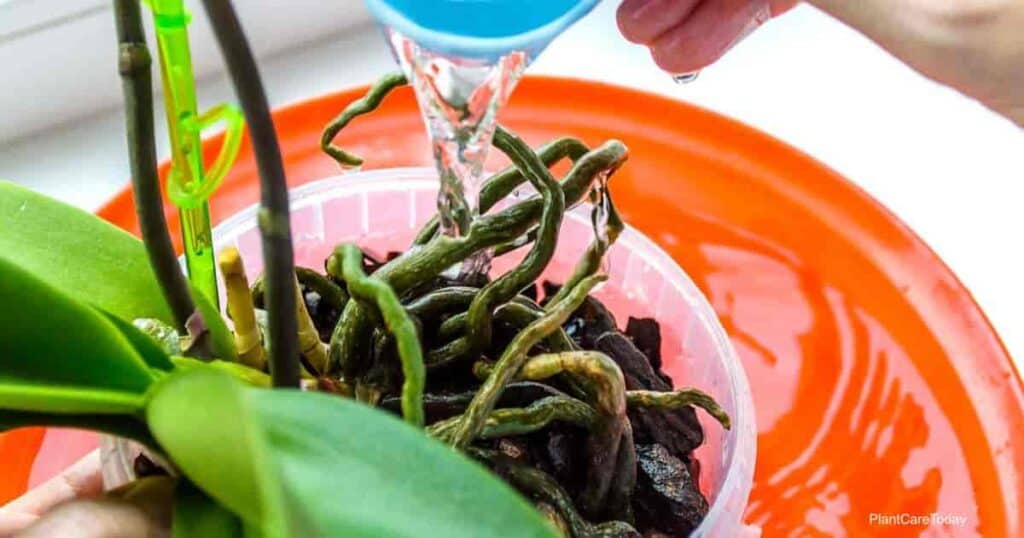Orchids are among the most beautiful and varied plants to grace gardens and homes.
However, orchids aren’t a mere genus of plants. They’re actually a family of more than 28,000 species across 763 genera called Orchidaceae.

The sheer variety of shapes and sizes these orchids can take also equates to varied care needs.
The good news is that it’s not that difficult to water your plant once you know the proper technique properly.
How To Water Your Orchid Correctly?
It can be challenging to water your orchids properly using traditional methods.
Luckily, the soak-and-dry method works beautifully with all varieties of orchids.
Why Calendars Are Bad?
The easiest way to give your plants too much or too little water is to use the calendar method.
This is the technique most of us were taught from a young age, and it happens to be one of the worst things you can do to your plant.
More than 97% percent of the water plants absorb is actually used in a process similar to sweating called transpiration.
This increases the humidity levels around a plant and affects other functions such as photosynthesis.
Many factors can affect how much or how often a plant drinks, such as temperature, sunlight intensity, and humidity levels.
By giving your plant a specific amount of water at specific intervals, you ignore all of these variables and can easily give the plant too much or too little water.
Know Your Orchid
This is an essential point for care in general but one often overlooked.
When you have over 28,000 species and untold numbers of cultivars, the care needs from one plant to another vary greatly.
For example, some orchids are adapted to mountains while others are adapted to swamps.
The good news is that the soak-and-dry method relies on signals from the soil, not the plant, so it tends to be foolproof even if you don’t know your orchid’s species or cultivar name.
However, it’s best to identify all of your plants so you can give them the best possible care.
While a 1″ inch depth will work for all orchids, knowing the species or cultivar can give you a more precise depth to look for.
The depth is based on a plant’s root depth, and some species have deeper roots, meaning you don’t need to water as often.
In fact, some plants may only need to be watered once the dryness reaches 4″ inches down.
Since proper watering means knowing when to stop, there’s a bit of leeway in how deep you need to check, as long as you never check deeper than the plant’s recommended depth.
The Benefits Of The Soak And Dry Method
As mentioned, the soak and dry method doesn’t rely on obscure signs or plant damage to tell you when it’s time to water.
Instead, the level of soil dryness lets you know when it’s time to water and when the plant has enough water.
The method even gives some leeway, making it easy to master for indoor and outdoor plants.
Because you’re checking the soil instead of the plant, all of those variables are automatically accounted for.
The Finger Trick
Another benefit of the soak and dry method is that you don’t need any special equipment—a finger will do.
The index finger on the average-sized adult human hand measures approximately 1″ inch from the fingertip to the first knuckle, from the first to the second knuckle, and from the second knuckle to the finger’s base.
This means you can measure up to 3″ inches of soil depth with your finger alone.
If you have a smaller hand (or your child wants to help water the plants), just stick a ruler beside the finger and make a mental note of where each inch is.
You’ll have these distances memorized after doing the finger trick a few times.
While all orchids vary, a safe general depth to check for is 1″ inch.
Stick your finger in the soil aiming straight down.
If the soil feels dry down to 1″ inch, it’s time to water, but it’s not yet time if it feels damp.
Most people can feel the dampness, but pull your finger straight back out and look at it if you can’t tell from feeling alone.
Dry soil will be lighter and somewhat dusty, but moist soil will be darker and tend to stick to the finger.
Using The Soak And Dry Method (Indoor And Outdoor Plants)
Once you’ve determined it’s time to water, the soak and dry method come into play.
You can use anything for pouring the water, but a small watering can is the easiest to control.
Add some room temperature water (natural rainwater is best, followed by distilled or baby water) to your can or cup
The whole trick to this method is to pour slowly.
If you begin pouring and the soil immediately soaks up the water, you’re pouring at a good rate, but if it takes a moment to absorb, you’ll want to slow the rate you pour.
Once you have a reasonable flow rate, do the following tips:
- Begin working your way around the plant, making sure to water the ground evenly, so there’s good distribution.
- Avoid getting the foliage wet as this can potentially cause sunburn or lead to other problems.
You’ll know it’s time to stop watering both indoor and outdoor plants if the soil can no longer absorb at the same rate that you’re pouring.
This is because the soil is sufficiently saturated.
You can also keep an eye on the drainage holes for indoor plants.
When you see moisture beginning to seep out, it’s a clear indicator that the soil is saturated, and you can stop watering.
